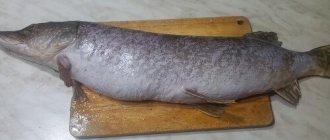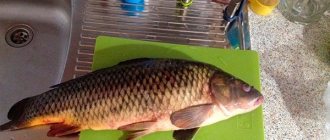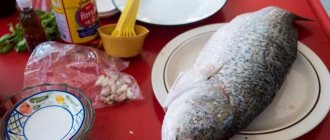Homemade dried roach is a healthy and very tasty snack for foamy drinks and boiled potatoes. This fish can be consumed without fear for your own health and figure: the calorie content of 100 g of roach is only 88 kcal, and its meat is rich in vitamins and minerals valuable for the body. It is rarely used for preparing fish soup and main courses and is never smoked. The size of the roach is ideal for drying. Anyone can prepare such a snack at home; it is only important to strictly follow the rules for salting and drying roach.
Salty
Time spent on preparation is 3 days.
Calorie content 100 gr. – 88 kcal, of which proteins – 26 g, fats – 27 g, carbohydrates – 0 g.
The number of servings for this recipe depends on how much fish you have.
To pickle taranka at home, you need the following components:
- Roach – 3 kg;
- Salt – 1 kg;
- Food saltpeter – 100 gr.
- Before salting the roach, you need to rinse it thoroughly. Mix salt and nitrate in one container. Coat each fish thoroughly with the resulting mixture.
- The main condition for tasty salted fish is that it must be fresh, just caught or purchased from a trusted fisherman. It is not recommended to salt frozen roach. It is better to subject it to heat treatment.
- First place a layer of fish on the bottom of a large container, cover it with the salt mixture and alternate until the end of the fish.
- Cover with a lid and secure everything with pressure. Put everything in a cool place and leave it like that until the roach is completely salted. It turns out to be a nicely priced snack to go with beer.
- This way you can make absolutely any river fish: crucian carp, silver carp or small carp. Everything should look something like the following photo.
Bon appetit!
Drying roach
Drying occurs the same for both methods. To ensure that the dried roach hangs correctly, you can use straightened paper clips. In addition, most experts on preparing dried fish advise hanging it not in the scorching sun, but in places with a draft, because then the dried fish will not be dry, but juicy and pleasant to the taste.
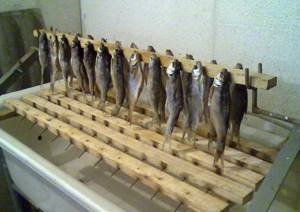
Depending on the size of the fish, the roach needs to be dried for one to two weeks.
Its readiness is checked by bending the fish from the head of the tail: if the fish easily bends and straightens, it is ready for consumption, otherwise, the fish must be kept in the sun or draft for a few more days.
Any experienced fisherman can tell you how to dry roach, however, the technology for each of them is different: some prefer to store fish in plastic or enamel containers, while others are the owners of special wooden barrels, because in this case, dried roach has its own calorie content increases. In any case, each of the recipes undoubtedly has its own advantages and disadvantages.
More such recipes on our website:
- Dried roach - photo of how to properly salt roach, dry it and dry this fish. For the average lover of dried and salted fish product, there is little difference between ram and roach. But connoisseurs claim that the roach is dried, the photo of which you...
- Salting ram at home - how to salt ram correctly Everyone knows that salted fish lasts longer. Therefore, in order to stock up on ram for future use, you need to know how to properly salt ram...
- Roach - cooking recipes from experienced fishermen The ideal option is to buy this fish from trusted sellers, since it spoils very quickly. It is this circumstance that makes it almost impossible to purchase roach in supermarkets. Ideal…
- How to cook roach in the oven The simplest recipe for busy housewives or for quickly entertaining guests - how to cook roach in the oven - will show that it can be done quickly and...
Dried
Cooking time is several days.
Calorie content 100 gr. – 132 kcal., of which proteins – 24 g, fats – 27 g, carbohydrates – 0.2 g.
The number of servings for this recipe depends on how much fish is available.
Before drying fish, you need to make sure that you have the following simple ingredients:
- Fresh roach – 5 kg;
- Salt – 1.5 kg;
- To properly dry the ram, you must first rinse it thoroughly under running water. After this, pat each fish thoroughly with paper napkins or towels. Place in a large flask or saucepan. Cover everything with the salt mixture and leave.
- If you salt the fish not only using the usual ingredients, but add a little coriander, you will get aromatic, spicy-salted roach.
- Secure it with pressure and place it in the refrigerator for several days. After this, remove the fish, thoroughly soak it from salt and hang it on a rope on the balcony or in the courtyard of a private house to dry. The result is a very tasty dried ram, which goes well with both a foamy drink and boiled potatoes.

Types and methods of salting river fish
It’s hard to imagine real Russian cuisine without river fish. The river dweller is good in fish soup and other fish soups; it is boiled in water, steamed, dried, dried and salted. If large freshwater inhabitants can be cleaned, cut and salted into pieces, then smaller bony specimens are better prepared whole with salt.
Attention! For salting any fish, only coarse salt is suitable. Only it, slowly dissolving, gradually draws liquid from the fish. Finely ground salt will only salt, but will not dry out river fish.
The principle of the ambassador is simple: salt does not preserve, it simply removes moisture from the fish. Salting of river dwellers can be wet, dry, mixed and sagging.
Tuzluchnaya
Preparation time – 4 days.
Calorie content 100 gr. – 239 kcal., of which proteins – 41 g, fats – 4.9 g, carbohydrates – 0.2 g.
Number of servings – 15.
- To salt roach in this way, you will need the same ingredients as in previous recipes. The main factor in properly salting fish is that the brine solution is not drained during the cooking process.
- In order to salt the ram, you need to rinse it well in several waters and drain all the liquid. In a separate container, mix salt (in the proportions of 3 kg of salt per 10 kg of fish) and a little sugar, add water and stir everything well. Pour it over the roach and leave everything in the refrigerator or cool cellar. This fish takes about 2-3 days to salt. In the same way you can make crucian carp, rudd or any other fish.
- After this, if desired, the roach can be dried, dried or immediately eaten. Bon appetit!
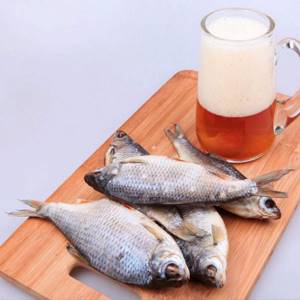
Taranka: secrets of preparing dried fish at home
The aromatic and tasty fish taranka (ram, ram) from the carp family has always been popular in the south of Russia and Ukraine - it was dried and served with beer. Subsequently, any dried fish, such as roach and roach, began to be called ram.
Dried taranka was the most accessible and cheapest snack in Rus', so it was very popular. All residents of Kuban and the Azov region know how to make ram: first, the fish is salted and then dried, as a result of which it acquires a special spicy taste and aroma.
You won't find a better snack to go with beer!
How to cook ram: selecting and processing fish
Since ram is now called any dried fish, for this dish you can take not only ram, roach or roach. Other varieties of fish are also suitable - bream, white bream, saberfish, pike, crucian carp, rudd, ruff and gudgeon.
Very tasty ram is obtained from blue bream, silver bream, whitefish, womer, perch and goby. The fish should be of medium fat content and small in size, otherwise it will not be salted and will spoil.
The fattest fish are bream, vomer and sabrefish have a medium fat content, ruff is very tender and has few bones, dried perch is sweetish, and pike is richly tart and piquant.
It is not necessary to process the fish in a special way to salt the ram - it is enough to rinse it well and remove the entrails if the fish is small. Some gourmets like ungutted ram - everyone has their own tastes.
However, in the summer, when the inhabitants of rivers and lakes feed on greens and microorganisms, it is better to gut even small fish, otherwise an unpleasant odor will appear during the drying process, and the taste of such ram will be bitter.
By the way, it is also better to remove the gills - they can ruin the taste of the fish.
How to salt the ram if you still decide to leave the insides? To do this, before salting, pour a saturated salt solution into the throat of the fish - for this reason, many people prefer to salt the ram live. The fish opens its mouth and swallows the brine, which makes it possible to properly salt the internal organs.
First, the fish is salted and then dried. How to pickle taranka at home? There are different recipes for salting ram, but usually they use two methods - wet and dry. The wet method is suitable for small fish, the dry method is suitable for large fish weighing more than 1 kg.
Wet salting of fish
According to this recipe, the ram is salted in a fairly concentrated brine, and the degree of salt concentration is checked with a raw egg - it should float to the surface.
A strong solution for salting fish is called brine, and the fish is kept in it for about 3-4 days, and so that it does not float and is salted evenly, it is covered with a metal mesh on top or a grate is placed on which a weight is placed. The bucket, basin or pan where the ram is salted should be placed in a cold place so that the fish does not spoil.
For wet salting, fish weighing less than 0.5 kg is usually taken. In general, the question of how much to salt the ram depends on the size of the fish - the larger it is, the longer the salting process will be.
After this, the salted fish is washed well and soaked in fresh water - small fish for 30 minutes, and large fish for several hours. In this case, it is recommended to change the water several times, and after the first change of water, let the fish lie in the air, come to its senses and allow the salt to be evenly distributed in the tissues.
Then you can put it in the water again, and when the fish starts to float, the soaking process can be considered complete. Don't worry about how to salt the ram without oversalting it - it is believed that it will absorb as much salt as needed.
Salted and soaked fish becomes slightly transparent and acquires a light amber hue.
How to make taranka correctly: dry salting method
First, rub the fish well with salt, pour salt into the belly, into the cut on the back and into the gills, if you decide not to remove them. The carcass is pierced with a fork or knife and salt is rubbed into the holes.
Place about 0.5 cm of salt in a large stainless steel metal dish, place the rams in tight rows, back down, and sprinkle generously with salt on top to create a true 1 cm thick layer of salt.
For 1 kg of fish, approximately 250 g of salt is required.
Make another layer, and then place a plate smaller than a pan or a wooden board on top - this is necessary to provide fresh air to the fish. Place a pressure on the lid and put the fish in a cold place, such as a refrigerator, cellar or balcony.
At the same time, make sure that the fish does not get exposed to sunlight. By the way, at first it is better to apply a little pressure, after about 6-7 hours you can increase it - this way the fish will be salted evenly.
It is interesting that in Rus', in villages, fish was salted in a wooden box with holes, which was placed in a spacious container.
During the salting process, liquid is formed that will have to be drained, and the salting time depends on the size of the battering ram. A fish weighing up to 100 g is salted for 1-2 days, a medium-sized fish weighing 600-800 g is enough for 3-4 days, and large fish will need from 5 to 14 days until completely salted.
As soon as the ram stops releasing juice, it is ready, but first it should be washed well and soaked in cold water for 2 hours, then kept in vinegar water for an hour - take about 50 ml of vinegar per bucket of water.
This is done to prevent the proliferation of pathogenic microorganisms, which cause the ram to deteriorate very quickly.
How to dry ram correctly
Make a double thread and string the fish on it at a distance of at least 7 cm from each other, passing it through the eyes so that the valuable fat and brine do not flow out through the mouth, but remain inside.
Some fishermen dry the ram on hooks, and place the small fish on a wooden surface and turn it over as it dries. This kind of ram turns out to be especially tasty, tender and rich.
Fish “garlands” should be hung in a well-ventilated place, but in the shade - in the attic or on the balcony, making sure there are no insects. By the way, soaking in vinegar water is a reliable preventive measure against flies, because the smell of vinegar repels them.
If flies land on your fish, it is best to discard it immediately as they may lay eggs on it. For more reliable protection against insects, it is better to put together a special box for drying fish and cover it with a fine mesh.
https://www.youtube.com/watch?v=naisDmS61yQ
Many people dry fish in Isidri dryers - in this case, you need to slightly open the ram's gills (if they have not been removed), trim the belly and secure it in the open form with toothpicks.
After 3 days, the fish can be considered dried. If you want dried ram, wait 2 weeks. Properly dried ram is neither soft nor hard, has a pleasant taste and smell, has a reddish-amber hue without yellow spots, and glows slightly in the light. Fish salted wet becomes more juicy after drying, while salting without water produces drier fish.
How to make ram delicious: secrets of gourmets
- For salting, use coarse salt, which has the ability to draw moisture from the fish. The less liquid there is in the fish, the faster it will dry out and become more tasty. In addition, fine salt forms a crust on the surface of the carcass and prevents the fish from becoming salty.
- Adding a small amount of sugar to the brine makes the fish very tender, piquant and tasty.
- How much weight should be pressed when salting? Typically a weight of 3–20 kg is placed, depending on the size of the fish and personal preference. If you salt fish in the summer, cover it with cloth or gauze to prevent insects from getting inside.
- If you want the fish to dry well, cut it slightly after salting. This applies mainly to large fish, because small fish dry out much faster.
- During dry salting, many housewives drain the brine from a pan or bucket manually, which is not very convenient. The ideal option is to drill holes in the bottom of the dish, and then the liquid will drain on its own. Then this dish can always be used for salting fish.
- If you dry out the ram, moisten it with water and wrap it in parchment for 2 days, periodically moistening the fish. Fish that is too dry can be ground to the consistency of flour and sprinkled on salads, soups and main courses.
We store the battering ram correctly
Dried taranka can be stored for up to 4 months if it is prepared according to all the rules. You can put it in layers in sterilized jars, roll up the lid and put it in the cellar - this way it will remain fresh for up to 10 months.
Often the fish is kept in a basket, bag, or wrapped in parchment paper, but dried fish only feels good in a cool place in a plastic bag or foil, and it has a shorter shelf life.
In the refrigerator, the ram is stored in the freshness zone - for this, the fish is greased with olive oil and placed in glass jars. You should not keep salted fish in the air for a long time, because fish oil oxidizes and the ram acquires a not very pleasant taste.
At low humidity, the fish becomes moldy, at high humidity it dries out, so ideal storage conditions are 80% humidity and a temperature of 3–8 °C. In kraft paper, coated on one side with polyethylene, the ram is stored for 8–10 months.
Taranka is a completely dietary and very healthy product, containing protein, valuable fish oil, iodine, chromium and many other useful substances.
Dried fish protein ensures proper metabolism, and omega-3 fatty acids protect against cancer, stroke and heart attack. Taranka makes incredibly tasty soups and snacks.
If you consider that the calorie content of taranka is only 88 calories, you can afford to eat it every day without fear for your figure!
Source: https://onashem.mediasole.ru/taranka_sekrety_prigotovleniya_sushenovyalenoy_ryby_v_domashnih_usloviyah
With entrails
Cooking time – 3 days.
Nutritional value 100 gr. finished product – 297 kcal., of which proteins – 41 g, fats – 4.9 g, carbohydrates – 0.4 g.
Number of servings – 10.
To prepare dried roach with intestines you need:
- Roach – 5 kg;
- Salt – 1.5 kg.
- Coriander – 100 gr.
- To prepare fish for drying, it is necessary to rinse it thoroughly in several waters without removing the intestines, scales and entrails.
- In order to salt roach using this method, you need to get a spacious wooden box or barrel. Place the fish on the bottom, salt everything thoroughly and sprinkle with coriander, cover everything with a lid and put it under pressure.
- Place in a cool place. It is salted for about 2-3 days. After this, soak the fish and you can serve it, dry it, or hang it out to dry. The fish should look something like the appetizer in the next photo.
The result is a very tasty, spicy-salted roach. Bon appetit!

Recipe for dried roach without gutting
Dried roach, whose calorie content is significantly higher than ram and roach, can be dried whole. To do this, well-washed, uncleaned and ungutted roach must be placed in “stacks” in a container with a generous layer of salt, and also sprinkled on each of the “orderly rows” of fish, covered with a flat lid, pressed down with a weight and left to salt for 2-3 days.
After several days, the fish should be thoroughly washed or left in cold (preferably ice) water for 1-2 hours, then dipped in a 2% vinegar solution mixed with sunflower oil - this will protect the drying fish from flies and other insects.
Particularly large specimens, according to the advice of most experts, still need to be cleaned of their entrails, since it is in them that, instead of the drying process, the decomposition process can begin, which is why the fish begins to rot and emit a nasty smell.
Without entrails
Cooking time – 3 days.
Nutritional value 100 gr. finished product – 297 kcal., of which proteins – 41 g, fats – 4.9 g, carbohydrates – 0.4 g.
Number of servings – 10.
- To properly dry fish according to this recipe, you need the same components as in previous variations.
- Before drying, rinse and gut the roach. It is good to cover both the inside and the bellies with salt. Place the fish at the bottom of a large container, sprinkle with salt, and put in the refrigerator or cellar.
- After this, you can dry the fish by hanging it on a reliable rope in the yard or on the balcony. The main thing is that the room is well ventilated.

How to dry ram correctly
Make a double thread and string the fish on it at a distance of at least 7 cm from each other, passing it through the eyes so that the valuable fat and brine do not flow out through the mouth, but remain inside. Some fishermen dry the ram on hooks, and place the small fish on a wooden surface and turn it over as it dries. This kind of ram turns out to be especially tasty, tender and rich. Fish “garlands” should be hung in a well-ventilated place, but in the shade - in the attic or on the balcony, making sure there are no insects. By the way, soaking in vinegar water is a reliable preventive measure against flies, because the smell of vinegar repels them. If flies land on your fish, it is best to discard it immediately as they may lay eggs on it. For more reliable protection against insects, it is better to put together a special box for drying fish and cover it with a fine mesh.
Many people dry fish in Isidri dryers - in this case, you need to slightly open the ram's gills (if they have not been removed), trim the belly and secure it in the open form with toothpicks.
After 3 days it can be considered dried. If you want dried ram, wait 2 weeks. Properly dried ram is neither soft nor hard, has a pleasant taste and smell, has a reddish-amber hue without yellow spots, and glows slightly in the light. Fish salted wet becomes more juicy after drying, while salting without water produces drier fish.



